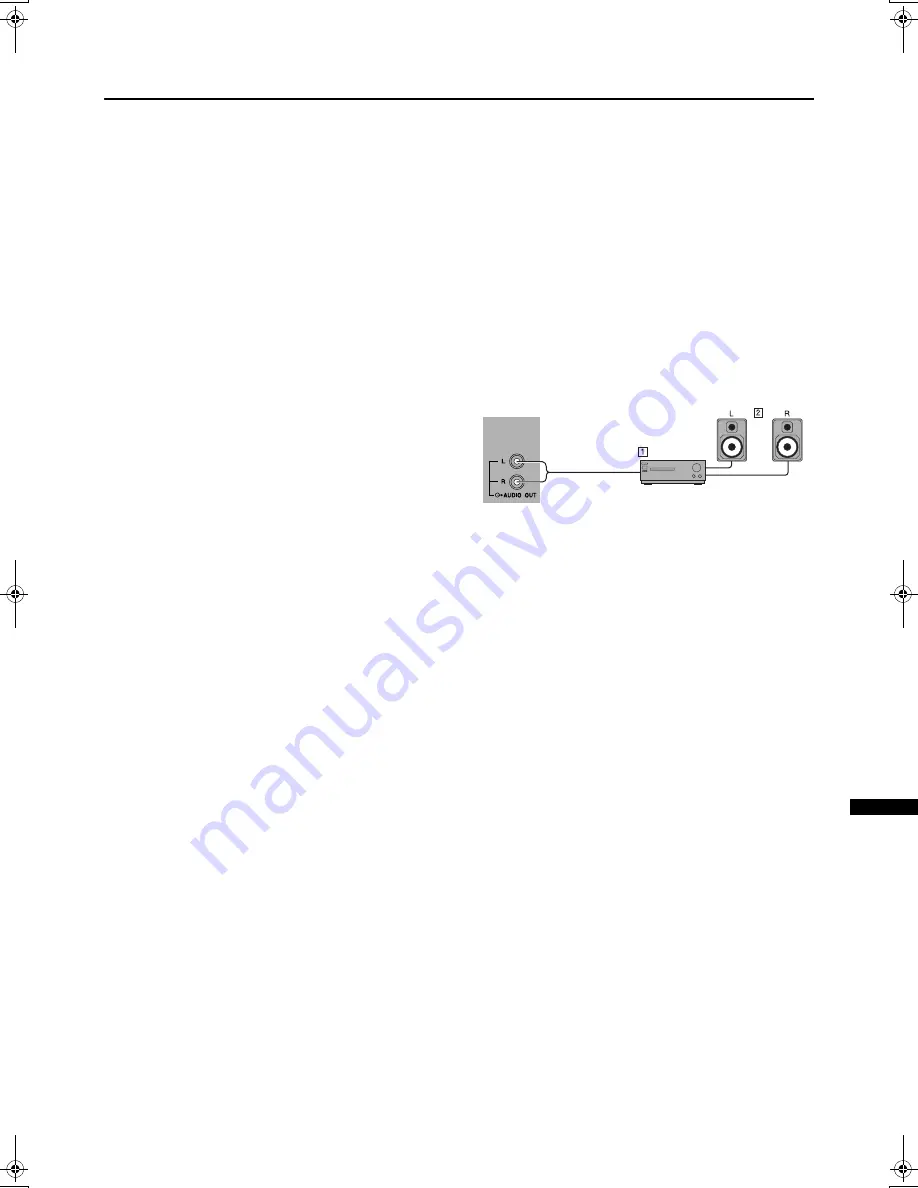
66
Further preparation
(TXLSPHQW
#
ZKLFK
#
FDQ
#
RXWSXW
#
WKH
#
(TXLSPHQW
#
ZKLFK
#
FDQ
#
RXWSXW
#
WKH
#
(TXLSPHQW
#
ZKLFK
#
FDQ
#
RXWSXW
#
WKH
#
(TXLSPHQW
#
ZKLFK
#
FDQ
#
RXWSXW
#
WKH
#
6
0
9,'(2
#
VLJQDO
#+
<
2
&
#
VLJQDO
,#
VXFK
#
DV
#
6
0
9,'(2
#
VLJQDO
#+
<
2
&
#
VLJQDO
,#
VXFK
#
DV
#
6
0
9,'(2
#
VLJQDO
#+
<
2
&
#
VLJQDO
,#
VXFK
#
DV
#
6
0
9,'(2
#
VLJQDO
#+
<
2
&
#
VLJQDO
,#
VXFK
#
DV
#
DQ
#
6
0
9+6
#
9&5
DQ
#
6
0
9+6
#
9&5
DQ
#
6
0
9+6
#
9&5
DQ
#
6
0
9+6
#
9&5
Connect the equipment to an EXT terminal (but not the
EXT-1 terminal).
You can choose between an S-VIDEO signal (Y/C signal) and
a regular video signal (composite signal). For details of how
to operate the equipment, see “
K
(S-VIDEO input)” on
page 21.
7
0
9
#
/,1.
#
FRPSDWLEOH
#
9&5
7
0
9
#
/,1.
#
FRPSDWLEOH
#
9&5
7
0
9
#
/,1.
#
FRPSDWLEOH
#
9&5
7
0
9
#
/,1.
#
FRPSDWLEOH
#
9&5
Be sure to connect the T-V LINK compatible VCR to the
EXT-2 terminal. If not, the T-V LINK function will not work
properly.
•
When connecting a T-V LINK compatible VCR to the
EXT-2 terminal, be sure to connect the decoder to the
VCR. If not, the T-V LINK function may not work properly.
After you have stored TV channels in the programme
numbers (PR) list, set the DECODER (EXT-2) function for
the programme number (PR) to ON to unscramble a
scrambled TV channel. For details, see “Using the
DECODER (EXT-2) function” on page 30.
&RQQHFWLQJ
#
KHDGSKRQHV
&RQQHFWLQJ
#
KHDGSKRQHV
&RQQHFWLQJ
#
KHDGSKRQHV
&RQQHFWLQJ
#
KHDGSKRQHV
Connect the headphones with a stereo mini-jack (3.5mm
diameter) to the headphone jack at the TV front panel.
•
When you connect the headphones, the TV speakers go
off.
9LGHR
#
RU
#
VRXQG
#
VLJQDO
#
RXWSXW
#
IURP
#
9LGHR
#
RU
#
VRXQG
#
VLJQDO
#
RXWSXW
#
IURP
#
9LGHR
#
RU
#
VRXQG
#
VLJQDO
#
RXWSXW
#
IURP
#
9LGHR
#
RU
#
VRXQG
#
VLJQDO
#
RXWSXW
#
IURP
#
WKH
#
(;7
05#
WHUPLQDO
WKH
#
(;7
05#
WHUPLQDO
WKH
#
(;7
05#
WHUPLQDO
WKH
#
(;7
05#
WHUPLQDO
You can change over the output of the video/sound signal
from the EXT-2 terminal. This is useful when you want to dub
the video/sound from another device onto the VCR connected
to the EXT-2 terminal. For details on how to do this, see
“DUBBING” on page 22.
79
#
RXWSXW
#
IURP
#
WKH
#
(;7
04#
WHUPLQDO
79
#
RXWSXW
#
IURP
#
WKH
#
(;7
04#
WHUPLQDO
79
#
RXWSXW
#
IURP
#
WKH
#
(;7
04#
WHUPLQDO
79
#
RXWSXW
#
IURP
#
WKH
#
(;7
04#
WHUPLQDO
The video/sound signal of a TV channel you are viewing is
always output from the EXT-1 terminal.
•
Changing over a programme number (PR) also changes
over the TV output from the EXT-1 terminal.
•
The video/sound signal from an EXT terminal cannot be
output.
•
Teletext programmes cannot be output.
■
■
■
■
&RQQHFWLQJ
#
VSHDNHUV
#
RU
#
DQ
#
&RQQHFWLQJ
#
VSHDNHUV
#
RU
#
DQ
#
&RQQHFWLQJ
#
VSHDNHUV
#
RU
#
DQ
#
&RQQHFWLQJ
#
VSHDNHUV
#
RU
#
DQ
#
DPSOLILHU
DPSOLILHU
DPSOLILHU
DPSOLILHU
See the audio equipment connection diagram below and
connect the audio equipment to the TV.
You can use external front speakers to listen to the TV sound,
instead of the TV speakers. For details of how to use them,
see “Turning the TV’s speakers off” on page 31.
Before connecting anything:
•
Read the manuals that came with the amplifier and
speakers.
•
Turn the TV and amplifier off.
•
To prevent magnetism from the speakers affecting the TV
screen, use magnetic-shielded speakers for the front
speakers.
•
Connecting cables are not supplied.
1
Amplifier
2
Front speakers (magnetic-shielded type)
•
Connecting headphones to the TV does not cut off the
output from the AUDIO OUT terminal. You cannot cut the
sound from the front speaker even if you connect
headphones to the TV.
•
Setting the volume of the amplifier too high may damage
the front speakers.
(Terminals on rear)
AV28S2EK.book Page 33 Wednesday, December 20, 2000 5:04 PM

















